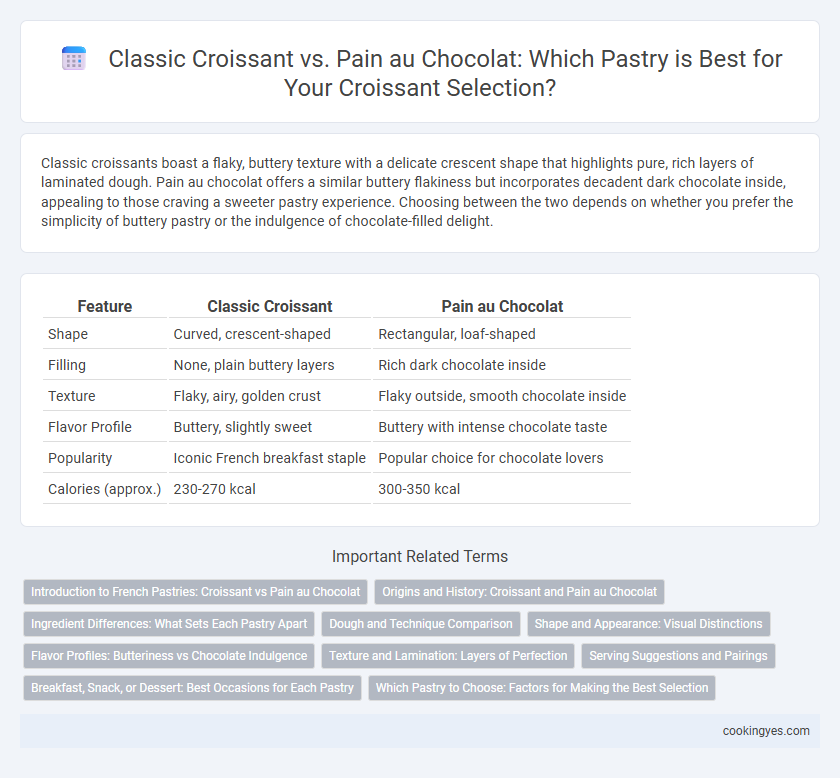Classic croissants boast a flaky, buttery texture with a delicate crescent shape that highlights pure, rich layers of laminated dough. Pain au chocolat offers a similar buttery flakiness but incorporates decadent dark chocolate inside, appealing to those craving a sweeter pastry experience. Choosing between the two depends on whether you prefer the simplicity of buttery pastry or the indulgence of chocolate-filled delight.
Table of Comparison
| Feature | Classic Croissant | Pain au Chocolat |
|---|---|---|
| Shape | Curved, crescent-shaped | Rectangular, loaf-shaped |
| Filling | None, plain buttery layers | Rich dark chocolate inside |
| Texture | Flaky, airy, golden crust | Flaky outside, smooth chocolate inside |
| Flavor Profile | Buttery, slightly sweet | Buttery with intense chocolate taste |
| Popularity | Iconic French breakfast staple | Popular choice for chocolate lovers |
| Calories (approx.) | 230-270 kcal | 300-350 kcal |
Introduction to French Pastries: Croissant vs Pain au Chocolat
Classic croissants boast flaky, buttery layers created through traditional lamination techniques, offering a delicate texture and rich aroma that define French pastry excellence. Pain au chocolat, also known as chocolatine in some regions, features a similar laminated dough but incorporates dark chocolate batons, providing a sweet contrast to the buttery pastry. Choosing between the two hinges on preference for pure buttery crispness versus the indulgent addition of chocolate, both staples of French bakery culture.
Origins and History: Croissant and Pain au Chocolat
The croissant originated in Austria in the 17th century, inspired by the kipferl, and later became synonymous with French pastry culture after its introduction to Paris in the 19th century. Pain au chocolat, a staple of French patisserie, evolved as a variation using laminated dough filled with dark chocolate, believed to have gained popularity in the late 19th century. Both pastries share roots in Viennese baking traditions but have distinctly unique identities shaped by regional ingredients and cultural preferences.
Ingredient Differences: What Sets Each Pastry Apart
Classic croissants feature a laminated dough made primarily from flour, butter, water, sugar, yeast, and salt, creating a flaky, buttery texture with no fillings. In contrast, pain au chocolat uses the same laminated dough but includes rich dark chocolate sticks at its core, adding a sweet, creamy contrast to the buttery layers. The key ingredient difference lies in the presence of chocolate, which defines pain au chocolat's distinctive flavor and separates it from the traditional, plain croissant.
Dough and Technique Comparison
Classic croissants feature a laminated dough made from layers of butter and yeast-leavened dough, creating a flaky, airy texture through repeated folding and rolling. Pain au chocolat uses the same laminated dough but incorporates chocolate batons, requiring precise lamination to prevent dough sogginess and maintain the pastry's rise. Both pastries depend on skillful dough temperature control and folding techniques to achieve optimal flakiness and structure.
Shape and Appearance: Visual Distinctions
Classic croissants feature a crescent shape with a golden-brown, flaky exterior showcasing distinct layers from buttery lamination. Pain au chocolat, by contrast, presents a rectangular form with a smooth, shiny surface often topped with pearl sugar and visible dark chocolate stripes through the dough folds. The visual distinction lies in the croissant's curved silhouette and layered texture versus the pain au chocolat's boxy shape and glossy finish.
Flavor Profiles: Butteriness vs Chocolate Indulgence
Classic croissants deliver a rich, buttery flavor profile characterized by flaky, golden layers that emphasize the natural sweetness of high-quality butter. Pain au chocolat offers a decadent chocolate indulgence with smooth, dark chocolate batons enveloped in the same buttery, laminated dough, creating a perfect balance between crispness and creamy richness. Choosing between the two hinges on whether you prefer the pure, savory butteriness of traditional pastry or the sweet, luxurious taste of chocolate-filled croissant.
Texture and Lamination: Layers of Perfection
Classic croissants showcase delicate, flaky layers achieved through meticulous lamination, resulting in a light, airy texture that melts in the mouth. Pain au chocolat combines the same buttery, layered dough with rich chocolate filling, offering a contrast between crisp exterior and smooth, creamy interior. Both pastries exemplify expert lamination techniques, but the classic croissant emphasizes pure texture while pain au chocolat enhances complexity with its luscious chocolate center.
Serving Suggestions and Pairings
Classic croissants pair perfectly with a variety of breakfast spreads like butter, jam, or honey, enhancing their flaky, buttery layers. Pain au chocolat complements coffee or hot chocolate beautifully, as its rich chocolate center adds a sweet contrast to the crisp pastry. Both pastries are ideal for brunch menus and can be served warm to maximize flavor and texture.
Breakfast, Snack, or Dessert: Best Occasions for Each Pastry
Classic croissants offer a light, flaky texture ideal for breakfast, pairing perfectly with coffee or jam to start the day. Pain au chocolat, featuring rich chocolate filling, excels as a mid-morning snack or indulgent dessert option. Choosing between these pastries depends on the desired experience: the croissant's buttery layers suit morning meals, while pain au chocolat satisfies sweet cravings during snack or dessert time.
Which Pastry to Choose: Factors for Making the Best Selection
Choosing between a classic croissant and a pain au chocolat depends on flavor preferences and texture desires; the croissant offers a flaky, buttery crescent ideal for those seeking a light, airy pastry, while pain au chocolat provides a richer experience by combining the same layers with decadent dark chocolate. Consider the occasion and taste balance--croissants pair well with coffee and breakfast settings, whereas pain au chocolat suits those craving a sweeter, dessert-like treat. Both pastries share a laminated dough base but vary in filling and sweetness, guiding your selection based on whether you prefer pure buttery bliss or chocolate indulgence.
Classic croissant vs pain au chocolat for pastry selection Infographic

 cookingyes.com
cookingyes.com